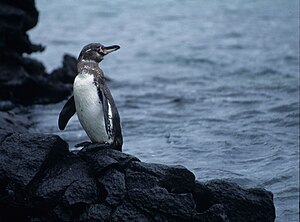Library:Modelling microplastic bioaccumulation and biomagnification potential in the Galápagos penguin ecosystem using Ecopath and Ecosim (EwE) with Ecotracer (research)

Modelling microplastic bioaccumulation and biomagnification potential in the Galápagos penguin ecosystem using Ecopath and Ecosim (EwE) with Ecotracer is a research article published in PLoS ONE in 2024. The article presents the results of a trophodynamic ecosystem modelling study that aimed to assess the exposure and effects of microplastic pollution on the Galápagos penguin (Spheniscus mendiculus) and its food web. The authors used two Ecopath with Ecosim models, one focused on the Galápagos penguin food web and the other on the Bolivar Channel Ecosystem, and applied the Ecotracer routine to simulate the bioaccumulation and biomagnification of microplastics over time. The authors also compared the model predictions with empirical data collected from seawater and biotic samples in the Galápagos Islands. The main findings of the study were:
- Microplastics can bioaccumulate in all predator-prey relationships, but biomagnification is highly dependent on the elimination rate of different plastics.
- The Galápagos penguin had the highest level of microplastics per unit of biomass among the functional groups in both models, followed by barracuda and anchovy.
- The trophic magnification factor (TMF) was significantly greater than 1 for both models, indicating that microplastics biomagnify in the food web.
- The model predictions were consistent with the empirical data for zooplankton and fish, but underestimated the microplastic concentrations in penguin scat.
The authors concluded that the ecosystem modelling approach provided novel insights into the potential risks of microplastics to the Galápagos penguin and other endemic and endangered species in the Galápagos Islands. They also suggested that more research is needed to determine the elimination rates of different plastics and the ecotoxicological effects of microplastics on marine organisms. The authors recommended that regional policies and management efforts should be implemented to reduce marine plastic pollution and conserve the unique biodiversity of the Galápagos Marine Reserve.
See also
- Headlines: Galápagos Penguins Face Microplastic Crisis, Urgent Action Needed
- Penguin Portal
- Penguin news
- Penguin videos
- Penguin research
- Penguins - Animal Hub
- Penguins - Newshound
